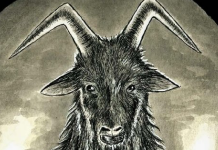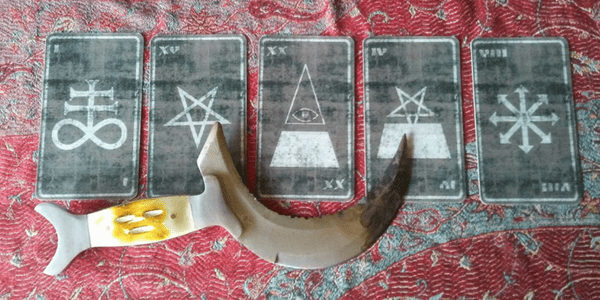
Infernal Geometry and the Left-Hand Path: The Magical System of the Nine Angles, by Toby Chappell
Inner Traditions, 9781620558164, 324 pp., 2019
What drew me to want to read Infernal Geometry and the Left-Hand Path: The Magical System of the Nine Angles by Toby Chappell was that I wanted to learn about a subject I knew very little about. This looked like the book that would contain a lot of valuable information, and it was written by Toby Chappell, the Grand Master of the Order of the Trapezoid, a person who would know the subject well. The fact that it also contains contributions from Michael Aquino, PhD and Stephen E. Flowers, PhD who are two other prominent members of the Temple of Set and writers on left-hand path topics was an added bonus.
Toby Chappell has been a member of the Temple of Set since 2000 and since 2015, he has been the Grand Master of the Order of the Trapezoid within the Temple. He is a lecturer and writer on Left-Hand Path subjects and has written articles on Satanism, the runes, and angular magick.
Infernal Geometry begins with a forward, in this case a “Forweird,” by Michael Aquino. He gives a brief explanation of how the ancient Egyptians understood their environment. The concepts of “neter” and “neteru” are explained: neter being the force which is behind regular occurrences, such as the course of the stars, and the neteru are what created the physical environment and “natural law.” I agree with him when he says that Set and those inspired by him are responsible for the amazing creations in film, music, architecture, and books. He concludes by telling the reader that unlike Necronomicon by H.P. Lovecraft, this book is not fictional.
Toby Chappell begins the book with a prelude where he discusses The Satanic Rituals by Anton LaVey. He draws attention to three of the rituals: Die Elektrischen Vorspiele, the Ceremony of the Nine Angles, and The Call of Cthulhu. The last two rituals were inspired by H.P. Lovecraft and were written by Michael Aquino, who at the time held a very important position in the Church of Satan. The three rituals refer to the nine magick angles that provide a model for transforming the self through both action and introspection. As defined by this book, magick is:
The process by which perceptual changes are created and made permanent within the inner world, and which may, when needed, create phenomenal change in the outer world.1
Chappell states that the nine angles, as written about in this book, are a purely left-hand path system and they are not found in any other tradition. He defines the left-hand path as “the unending pursuit of enhancing and perpetuating the magician’s self-aware, psyche-centric existence.”2
He goes on to state, “this book is about the Nine Angles — and the theory and practice of angular magic — as developed within and practiced by the Temple of Set and its internal body the Order of the Trapezoid, however, it is not a doctrinal statement about either organization.”3
The Order of the Trapezoid first became known in December 1970 when Anton LaVey wrote about it in The Cloven Hoof, the newsletter for the Church of Satan. He stated that it was the board of directors, security staff, and advisors to the Church of Satan, though it is through the work of Michael Aquino that has caused it to grow to its present state. The name came from the Law of the Trapezoid, which was created by LaVey. Aquino summarizes it this way:
All obtuse angles are magically harmful to those unaware of this property. The same angles are beneficial, stimulating, and energizing to those who are magically sensitive to them.4
Chappell goes on to explain that there are keywords associated with the angles that define their essence. They are Chaos, Order, Understanding, Being, Creation, Sleep, Awakening, Re-Creation, and Perfection. The four angles of the Trapezoid are associated with Azathoth, Yog-Sothoth, Nyarlathotep, and Shub-Niggurath. The purpose of the Ceremony of the Nine Angles is so that the practitioner can experience “the shift in perspective and understanding that comes from working with strange angles.”5 The ritual is written in a magical language created by Aquino that stemmed from the speech of the Great Old Ones contained in the Lovecraftian stories The Call of Cthulhu and The Case of Charles Dexter Ward. Aquino called this language “Yuggothic.”
I particularly enjoyed reading the section on the different views of time, namely curved time and angular time. Curved time is explained as the “time that we experience as physical inhabitants of orderly cosmos,” and angular time is the “subjective experience of time by the non-natural psyche.”6 Chappell describes these using the keywords of the Nine Angles, making them easier to understand for the reader. I like how he used the creation process which made it relevant to my life as a writer.
The chapter titled “Historical Antecedents” discusses the meanings of the numbers three and nine. Nine was declared as a satanic number by LaVey because it always returns to itself in mathematical equations, therefore, it is the number of the ego. The number three appears often in magick in many different cultures. The “spiral force” was inscribed on a monument created by Ramses II. It can be expressed as “Xepera Xeper Xeperu.” Don Webb translates it as, “I have come into being, and by the process of my coming into being the process of coming into being is established.”7
Nine has a big significance in mythology and culture. Some examples are when Odin sacrificed himself and hung from a tree for nine nights in Norse cosmology, the Nine Worlds in Greek mythology, the nuses as nine goddesses, and in The Divine Comedy where Dante Alighieri divided Hell into nine circles.
Chappell goes on to explain sacred geometry, which is when symbolic meaning is given to geometric forms, proportions, and functions usually in a sacred or religious context. This is the reason churches and other religious buildings are designed in a certain way. He discusses the enneagram (a nine-pointed geometric figure that usually resembles a star), the Enochian Keys, John Dee and H.P. Lovecraft and their influence on occultism.
Further on in Infernal Geometry and the Left-Hand Path, Chappell gives some information on the pentagram. Despite what some may think, it is a very ancient symbol that existed as early as 3500 BCE. It was always inverted, and it was used as a sign of recognition by the Pythagoreans. It represents “the self-aware, self-evolving, and self-perpetuating psyche.”8 The one point down shows the need for continual balance, and the circle around it does not touch the pentagram in order to show that the psyche doesn’t depend on the objective universe.
Two types of rituals are discussed. The operative ritual which is performed to create a change in motion. It could be noticeable to the objective universe or it could only affect the subjective universe within the magician. The illustrative ritual is reflective, focused on the subjective universe itself. The purpose is to gain insight, understanding, and inspiration. The psychodrama is a type of illustrative ritual, an example is the Black Mass. Its method is not limited to the parody or blasphemy of the Catholic Mass, as many understand it to be. When one is shown the true nature of something and, because of this, they can never see it in the same positive way, it is the same principle at work as with the Black Mass. I want to stress this to show that the Black Mass is much more important than just acting out blasphemies at the altar.
I appreciate that Chappell referred to LaVey’s earliest writing and practices dating from the 1950s through 1975. He said during this time that LaVey was a “legitimate, practicing magician and Satanist,” and that there are references showing that LaVey saw Satanism as a religion and viewed Satan to be a real entity.9 He viewed the priesthood as a serious thing, and in a letter to Aquino in 1972, he wrote:
Why should it be easier to become a Priest of Satan than it is to become a Catholic priest, a Jewish rabbi, or a Methodist minister, when a Priest of Satan actually requires a great deal more wisdom, considering his terrestrial commitment?10
This is extremely relevant today, as there are so many people giving themselves fancy titles so they can flaunt them on social media, when in reality, they don’t mean much except to the person who enjoys writing “reverend” in front of their name, yet has done nothing to earn the title.
A lot of topics are covered in this book including creating proper ritual space, angular divination, and sigils. Rituals are also included such as a Ritual Awakening to the Angular Path, Daily Practice of the Angles, and the Star Trapezohedron.
Chappell advises that in order to get the most from the book, the reader should be familiar with H.P. Lovecraft’s The Haunter of the Dark, The Dreams in the Witch-House, and The Call of Cthulhu; Frank Belknap Long’s The Hounds of Tindalos; Anton LaVey’s Die Elektrischen Vorspiele, and Michael A. Aquino’s The Metaphysics of Lovecraft, The Ceremony of the Nine Angles, and The Call to Cthulhu.
I recommend Infernal Geometry and the Left-Hand Path: The Magical System of the Nine Angles to those interested in infernal or sacred geometry and have been on the left-hand path for some time. It is not a beginner’s book and the reader should have some prior knowledge of the occult and magick before performing any of the rituals. It can also be used as a scholarly book, for those who don’t want to perform the rituals, but want to learn about the subject matter.
Infernal Geometry concludes with an “Afterweird” by Stephen E. Flowers. He writes that he hopes that the reader has studied the book and not just read it, and that Chappell “shows the reader no mercy in this tome, as he is providing a set of obscene geometrical keys to do exactly that: correlate the contents of the mind, but not on the terms of someone or something else, but on the mind’s own terms.”11
This is followed by the appendices, which includes “Lovecraftian Ritual,” by Michael A. Aquino, “The Nine Angles of the Seal,” by Stephen E. Flowers, and “Keystone,” by Patty A. Hardy, Grand Master Emeritus of the Order of the Trapezoid. There are six pages of notes, a bibliography, and an index.









